Flock stock | Birders feed a growing niche of Maine's tourism industry
On a recent overcast morning, birding guide Scott Cronenweth was leading a group of 15 birders on a Maine Audubon ramble through the wild backside of Evergreen Cemetery in Portland. Every few minutes, he stopped and broke out in song.
“Tweecher, tweecher, tweecher,” he sang. The group, including retiree Mike Davis, paused, their sensible shoes planted firmly on the uneven terrain, their binoculars strapped around their necks. With many unseen birds singing overhead, the forest canopy emitted a constant sweet chirping. “That’s the ovenbird again,” Cronenweth said. “It’s one of the easier warblers to remember.”
The group strained to hear or see. They tilted their heads; they peered in the direction Cronenweth was looking. “Wichity, witchity, witchity,” Cronenweth crooned. “The common yellowthroat. Don’t forget to look low as well as high.”
The birders looked low and high. Cronenweth continued walking but quickly came to another stop. “Potato chip, potato chip,” he chirped, as he cocked his head toward an, to everyone else, inaudible sound far off in the trees. “The call of the American goldfinch.”
Carolyn Cimino, a birder from Connecticut, complimented Cronenweth: “You have very good hearing.”
Guided bird walks such as Cronenweth’s are common this time of year as migratory birds swoop back north for the breeding season. But birding as a year-round recreational pursuit is growing increasingly popular in Maine and throughout the country. Though Cronenweth’s tour members did not look like a particularly important part of the economy — they were dressed in jeans, sneakers, ball caps and had only binoculars on them — they represent a promising demographic for the state’s tourism industry.
Davis, a member of the tour who retired from a 25-year career at Unum and lives in Stockton Springs, lit up when he overheard a discussion about the economic impact of birders. “It’s very good for the economy,” he affirms. “My wife and I just spent two weeks in Big Bend National Park. As New Englanders, we were looking for birds we hadn’t seen before.”
That drive to travel all over to see spots of color in the wild and hear the trill of bird song is driving an economic surge, even while the populations of many bird species continue a troubling decline. In a 2006 birding survey, the U.S. Fish and Wildlife Service counted 48 million birders in the United States, who spent $12 billion on trip expenses, including food, lodging and transportation, and $24 billion on bird-watching equipment.
Moreover, the number of birders appears to be growing. According to a 2007 report by the U.S. Department of Agriculture’s Forest Service, birders in this country jumped from 54.4 million to 81.5 million between 1994 and 2006, helping support a claim often made by birdwatchers that their hobby is one the fastest-growing outdoor sports, second only to gardening. “Given the recession beginning in 2008, the desire for cheap travel closer to home, and the increase of baby boomers with disposable time, it would be reasonable to assume the next report [which will come out in 2012 or 2013] will reveal an even greater increase in bird watching,” spokeswoman Delta Willis of the National Audubon Society says.
While Maine has in the past few years begun developing its bird-based tourism industry, the state can still do more to take advantage of its birds, according to Chip Clouse of the American Birding Association in Colorado Springs. “You guys do have unique stuff there,” he says, unlike some states such as Oklahoma that lack rare birds. In Maine, you can see Atlantic puffins and other pelagic birds, like great shearwaters, Wilson’s storm-petrels and South Polar skuas. Maine also has unique northern forest species, such as the boreal chickadee, black-backed woodpecker, Bicknell’s thrush and spruce grouse. Despite this bird bounty, Clouse says Maine’s bird-watching industry is underdeveloped and under-utilized.
Maine’s birding people
If one person can be credited with having the vision to turn Maine into a birders’ paradise, it’s Bob Duchesne. Duchesne, a Democratic state representative from Hudson, has almost single handedly made Maine more birder friendly. This comes in part from his sense of public duty, and also from his own birding obsession, which started when he was a first-grader. “I am one of those who keeps a life list,” Duchesne writes in an e-mail, referring to the list kept by ardent birders documenting every bird they identify in the wild. “Three weeks ago, I turned up a Swainson’s Warbler in South Carolina — the 550th species I’ve seen in North America. It was the icing on the cake. My real target was a mangrove cuckoo in southern Florida that has been eluding me for three decades. (Got it in Naples, Florida.) That one bird alone inspired me to pump nearly $1,500 into the economy in chase of it.”
Yet he knows that to reap more benefit from bird devotees, he and others in Maine need to work harder to more closely knit birding with economic development. “We have to connect what we’re doing with the people offering resources,” he says, such as nature guides, innkeepers and boat tour operators.
Duchesne’s efforts to build Maine’s bird economy began in 2003 when he retired from his 31-year radio career and began researching good birding spots. He was also elected to the state Legislature that year. For the next five to six years, he visited more than 300 sites, putting 40,000 miles on his car. “I’d get out before daybreak,” he recalls, “and rush to Belgrade or Phippsburg and then rush back here [to Augusta] and get into my suit.”
When he finished his research, he reached out for support from Maine Audubon, as well as the state Department of Conservation, Office of Tourism and the Inland Fisheries and Wildlife department, to create the Maine Birding Trail. The trail is made up of 82 birding sites throughout the state, which are described and mapped on a foldable brochure. Duchesne says his birding trail in Maine dovetails with the fancies of middle-aged and older people. “As the baby boomers age, they are no longer doing white-water canoeing, mountaineering, team sports or other strenuous outdoor activities. But they retain their affection for the outdoors and they’ve embraced birding in big numbers,” he writes. “The Trail makes that activity much easier for people who are unfamiliar with an area of the country that they wish to visit.”
In 2008, the tourism office printed 20,000 copies of Duchesne’s map and distributed them around the state. “Much to everyone’s surprise, they disappeared in a heartbeat,” Duchesne says, convincing the state to immediately issue another 20,000. Since then, 95,000 brochures have been printed, according to Phil Savignano at the Maine Office of Tourism.
Savignano agrees that birding in Maine should be supported more. “We need to build more infrastructure so people can find the spots easily and park their cars comfortably. We need to put up signage,” he says, adding later, “We’re poking away at it but it is a huge project.”
Riding on his success with the birding map, Duchesne in 2009 published a guidebook that lists over 260 birding sites. Several thousand copies have been sold. He also maintains an active birding website, mainebirdingtrail.com, and a year ago started a Best Nests program for inns close to the trail. For a $50 annual fee (which Duchesne asks for as a sign of the innkeeper’s commitment, he says), Duchesne lists the lodging facility on his website, sends out a periodic newsletter on best practices, and, when he has time, customizes a birding guide for guests. So far, 30 inns have signed up, and he hopes that when he can devote more time to this project (his legislative duties end with the completion of his last term next spring), he will attract more.
Bob Hamer, executive director of the Moosehead Lake Region Chamber of Commerce in Greenville, says those offering resources to tourists also need to become more aware of the potential of birding. “Little by little it is coming along,” he says. “I think it will be a big thing pretty soon. Whether it is two, three years from now, bird watching will be major part of the income stream to this area.”
And this means local businesses must shift tactics, Hamer continues. “Traditionally we were all about fishing and hunting, [but chamber members] have to adjust to a new reality, because fewer people are hunting and fishing,” he says. “So to fill your beds, you have to go after a new type of outdoor enthusiast, whether it is mountain biking, waterfall viewing or bird watching.”
Bob Smith, the owner of Sebasco Harbor Resort near Phippsburg, says he joined Duchesne’s Best Nests program to advertise to would-be guests that his inn is bird friendly, somewhat like “pet friendly,” he jokes. “You can show up here and we can give you the resources to go out and enjoy,” Smith says. The number of birders who stay at Smith’s inn is small; his bird-oriented guests have grown from maybe one person five years ago to 10 last year. But this is still “exponential growth,” as he puts it.
Janice Dyer, co-owner of The Evergreen Lodge near Greenville, also wants to attract birders, extolling their virtues as guests. “Birders are a nice bunch of people,” she says. “Anyone who’s attuned to nature is nice to have.” Beyond being a Best Nester, her B&B collaborates with Duchesne to offer birding packages. For $140 a person, not including a room, a visitor can stay at Dyer’s lodge for a weekend bird-watching trip guided by Duchesne that includes breakfast, lunch and a discounted dinner at a nearby restaurant.
Greg Dugal, executive director of the Maine Innkeepers Association, recommends packaging to lure more birders. For instance, he says, an inn might offer a deal that includes transportation to a wildlife preserve and a voucher to a gift shop that sells birding memorabilia. “Packaging is the most important thing you can do. It creates something that someone is interested in, and from soup to nuts, it’s all done for them. It’s what people want, the one-stop,” he says.
What’s ahead
In the past couple of years, more people have joined Duchesne’s quest to develop Maine’s birding infrastructure. Since 1998, five birding festivals have started in Maine: The state’s oldest, in Bar Harbor, began in 1998, followed by ones in Cobscook Bay and Deer Isle. A fourth festival began in Presque Isle three years ago. This spring, Wolfe’s Neck Woods State Park in Freeport collaborated with Bradbury Mountain State Park in Pownal to hold the first southern Maine bird festival. In its first year, 330 people came out for it, bringing in $3,500 for the two parks, according to Andy Hutchinson, Wolfe’s Neck park manager.
“We knew there was a growing interest in birding,” Hutchinson says, adding that he has also been impressed by the success of other birding festivals in Maine, especially the one at Aroostook State Park. The mid-June festival manages to draw around 130 visitors a year despite being so far north, according to Aroostook State Park Manager Scott Thompson.
Meanwhile, a group of Down Easters has taken the Maine Birding Trail one step further by creating a local birding map with more detailed site information for Washington and Hancock counties. Mike McCabe, a retired Foreign Service officer and one of the mapmakers who lives in Whiting, says he hopes the map will attract tourists, especially to far-flung Washington County, which might get overlooked by the lure of Acadia National Park in Hancock County. His wife runs the Puffin Pines Country Gift Store next door to their home. “If you look at a map of Maine, tourists come from the west to Acadia, and only a few filter through to Washington County,” he says. The group, which is funded by a grant from the Maine Office of Tourism, is printing 10,000 copies to start.
Anne Beerits worked with McCabe on the Down East and Acadia Birding Trail. She owns Nervous Nellie’s Jams and Jellies in Deer Isle, a jam-making business that offers a free coffee and scone to anyone who walks in during the Deer Isle May 20-22 birding festival with a pair of binoculars. She points out that birders help stretch the tourism season. “Birding happens at times of the year when tourism is not peaking, like now, during spring migration and during the fall. We wanted to jumpstart the season a little bit,” she says.
Beerits says the map and the festival will draw in not only visitors, but also help support habitat preservation. “We’re trying to raise awareness among business owners on that island that birders are good business, and that they’re here because of our undeveloped habitat,” she says. “It is an argument about protecting and conserving those lands.“
Michael Good, who started Maine’s first birding festival in Bar Harbor 13 years ago, echoes Beerits’ sentiment. “It’s not just about the birds, and counting every bird, although we’re all into the counting,” he says. “It’s about getting people to focus on ecology to bring back our ecology. This is a broader economic effort than just a birding festival; this is about our future in Maine.”
Feathered favorites
Maine has 360 species of birds, but only a fraction inspire birders to travel to Maine’s coast and forests to catch a glimpse of them. Although no formal study has been done on Maine’s most tourist-tempting birds, Mainebiz compiled a Top 10 list from Maine birding guides Derek Lovitch, Scott Cronenweth and Bob Duchesne. In no particular order, Maine’s most sought-after birds are:
Atlantic puffin
Bicknell’s thrush
Razorbill
Black-backed woodpecker
Boreal chickadee
Saltmarsh sparrow
Nelson’s sparrow
Spruce grouse
Roseate tern
Gray jay
Rebecca Goldfine, Mainebiz staff writer, can be reached at rgoldfine@mainebiz.biz.
COVER BIRD PHOTOS: Ovenbird (top)/Dominic sherony, http://www.flickr.com/photos/9765210@N03/; COMMON YELLOW THROAT (right), http://www.flickr.com/photos/seabamirum/; OTHERs COURTESY/U.S. FISH AND WILDLIFE.

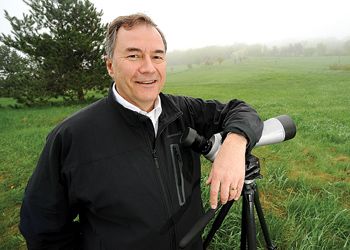
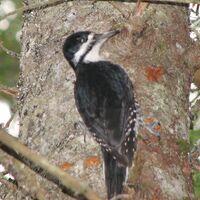
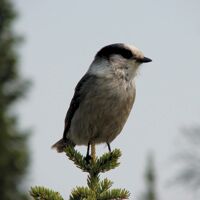
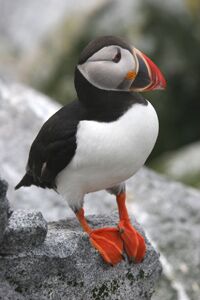
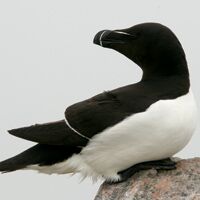










Comments